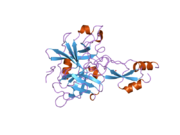SPINT1
Protein-coding gene in the species Homo sapiens
| SPINT1 | |||||||||||||||||||||||||||||||||||||||||||||||||||
|---|---|---|---|---|---|---|---|---|---|---|---|---|---|---|---|---|---|---|---|---|---|---|---|---|---|---|---|---|---|---|---|---|---|---|---|---|---|---|---|---|---|---|---|---|---|---|---|---|---|---|---|
 | |||||||||||||||||||||||||||||||||||||||||||||||||||
| |||||||||||||||||||||||||||||||||||||||||||||||||||
| Identifiers | |||||||||||||||||||||||||||||||||||||||||||||||||||
| Aliases | SPINT1, HAI, HAI1, MANSC2, serine peptidase inhibitor, Kunitz type 1 | ||||||||||||||||||||||||||||||||||||||||||||||||||
| External IDs | OMIM: 605123; MGI: 1338033; HomoloGene: 9653; GeneCards: SPINT1; OMA:SPINT1 - orthologs | ||||||||||||||||||||||||||||||||||||||||||||||||||
| |||||||||||||||||||||||||||||||||||||||||||||||||||
| |||||||||||||||||||||||||||||||||||||||||||||||||||
| |||||||||||||||||||||||||||||||||||||||||||||||||||
| |||||||||||||||||||||||||||||||||||||||||||||||||||
| |||||||||||||||||||||||||||||||||||||||||||||||||||
| Wikidata | |||||||||||||||||||||||||||||||||||||||||||||||||||
| |||||||||||||||||||||||||||||||||||||||||||||||||||
Kunitz-type protease inhibitor 1 is an enzyme that in humans is encoded by the SPINT1 gene.[5]
The protein encoded by this gene is a member of the Kunitz family of serine protease inhibitors. The protein is a potent inhibitor specific for HGF activator and is thought to be involved in the regulation of the proteolytic activation of HGF in injured tissues. Alternative splicing results in multiple variants encoding different isoforms.[5]
References
- ^ a b c GRCh38: Ensembl release 89: ENSG00000166145 – Ensembl, May 2017
- ^ a b c GRCm38: Ensembl release 89: ENSMUSG00000027315 – Ensembl, May 2017
- ^ "Human PubMed Reference:". National Center for Biotechnology Information, U.S. National Library of Medicine.
- ^ "Mouse PubMed Reference:". National Center for Biotechnology Information, U.S. National Library of Medicine.
- ^ a b "Entrez Gene: SPINT1 serine peptidase inhibitor, Kunitz type 1".
Further reading
- Dahl M, Hersh CP, Ly NP, et al. (2005). "The protease inhibitor PI*S allele and COPD: a meta-analysis". Eur. Respir. J. 26 (1): 67–76. doi:10.1183/09031936.05.00135704. PMID 15994391.
- Shimomura T, Denda K, Kitamura A, et al. (1997). "Hepatocyte growth factor activator inhibitor, a novel Kunitz-type serine protease inhibitor". J. Biol. Chem. 272 (10): 6370–6. doi:10.1074/jbc.272.10.6370. PMID 9045658.
- Yamada T, Tsujioka Y, Taguchi J, et al. (1998). "White matter astrocytes produce hepatocyte growth factor activator inhibitor in human brain tissues". Exp. Neurol. 153 (1): 60–4. doi:10.1006/exnr.1998.6874. PMID 9743567. S2CID 46233422.
- Kataoka H, Suganuma T, Shimomura T, et al. (1999). "Distribution of hepatocyte growth factor activator inhibitor type 1 (HAI-1) in human tissues. Cellular surface localization of HAI-1 in simple columnar epithelium and its modulated expression in injured and regenerative tissues". J. Histochem. Cytochem. 47 (5): 673–82. doi:10.1177/002215549904700509. PMID 10219059. S2CID 34649980.
- Lin CY, Anders J, Johnson M, Dickson RB (1999). "Purification and characterization of a complex containing matriptase and a Kunitz-type serine protease inhibitor from human milk". J. Biol. Chem. 274 (26): 18237–42. doi:10.1074/jbc.274.26.18237. PMID 10373425.
- Shimomura T, Denda K, Kawaguchi T, et al. (2000). "Multiple sites of proteolytic cleavage to release soluble forms of hepatocyte growth factor activator inhibitor type 1 from a transmembrane form". J. Biochem. 126 (5): 821–8. doi:10.1093/oxfordjournals.jbchem.a022522. PMID 10544273.
- Itoh H, Yamauchi M, Kataoka H, et al. (2000). "Genomic structure and chromosomal localization of the human hepatocyte growth factor activator inhibitor type 1 and 2 genes". Eur. J. Biochem. 267 (11): 3351–9. doi:10.1046/j.1432-1327.2000.01368.x. PMID 10824123.
- Kataoka H, Shimomura T, Kawaguchi T, et al. (2001). "Hepatocyte growth factor activator inhibitor type 1 is a specific cell surface binding protein of hepatocyte growth factor activator (HGFA) and regulates HGFA activity in the pericellular microenvironment". J. Biol. Chem. 275 (51): 40453–62. doi:10.1074/jbc.M006412200. PMID 11013244.
- Kataoka H, Meng JY, Itoh H, et al. (2001). "Localization of hepatocyte growth factor activator inhibitor type 1 in Langhans' cells of human placenta". Histochem. Cell Biol. 114 (6): 469–75. doi:10.1007/s004180000228. PMID 11201608. S2CID 25947109.
- Oberst M, Anders J, Xie B, et al. (2001). "Matriptase and HAI-1 are expressed by normal and malignant epithelial cells in vitro and in vivo". Am. J. Pathol. 158 (4): 1301–11. doi:10.1016/S0002-9440(10)64081-3. PMC 1891898. PMID 11290548.
- Strausberg RL, Feingold EA, Grouse LH, et al. (2003). "Generation and initial analysis of more than 15,000 full-length human and mouse cDNA sequences". Proc. Natl. Acad. Sci. U.S.A. 99 (26): 16899–903. Bibcode:2002PNAS...9916899M. doi:10.1073/pnas.242603899. PMC 139241. PMID 12477932.
- Kirchhofer D, Peek M, Li W, et al. (2003). "Tissue expression, protease specificity, and Kunitz domain functions of hepatocyte growth factor activator inhibitor-1B (HAI-1B), a new splice variant of HAI-1". J. Biol. Chem. 278 (38): 36341–9. doi:10.1074/jbc.M304643200. PMID 12815039.
- Clark HF, Gurney AL, Abaya E, et al. (2003). "The secreted protein discovery initiative (SPDI), a large-scale effort to identify novel human secreted and transmembrane proteins: a bioinformatics assessment". Genome Res. 13 (10): 2265–70. doi:10.1101/gr.1293003. PMC 403697. PMID 12975309.
- Colland F, Jacq X, Trouplin V, et al. (2004). "Functional proteomics mapping of a human signaling pathway". Genome Res. 14 (7): 1324–32. doi:10.1101/gr.2334104. PMC 442148. PMID 15231748.
- Zhang Z, Henzel WJ (2005). "Signal peptide prediction based on analysis of experimentally verified cleavage sites". Protein Sci. 13 (10): 2819–24. doi:10.1110/ps.04682504. PMC 2286551. PMID 15340161.
- Gerhard DS, Wagner L, Feingold EA, et al. (2004). "The status, quality, and expansion of the NIH full-length cDNA project: the Mammalian Gene Collection (MGC)". Genome Res. 14 (10B): 2121–7. doi:10.1101/gr.2596504. PMC 528928. PMID 15489334.
- Shia S, Stamos J, Kirchhofer D, et al. (2005). "Conformational lability in serine protease active sites: structures of hepatocyte growth factor activator (HGFA) alone and with the inhibitory domain from HGFA inhibitor-1B". J. Mol. Biol. 346 (5): 1335–49. doi:10.1016/j.jmb.2004.12.048. PMID 15713485.
- Fan B, Wu TD, Li W, Kirchhofer D (2005). "Identification of hepatocyte growth factor activator inhibitor-1B as a potential physiological inhibitor of prostasin". J. Biol. Chem. 280 (41): 34513–20. doi:10.1074/jbc.M502119200. PMID 16103126.
- Rual JF, Venkatesan K, Hao T, et al. (2005). "Towards a proteome-scale map of the human protein-protein interaction network". Nature. 437 (7062): 1173–8. Bibcode:2005Natur.437.1173R. doi:10.1038/nature04209. PMID 16189514. S2CID 4427026.
- v
- t
- e
PDB gallery
-
 1yc0: short form HGFA with first Kunitz domain from HAI-1
1yc0: short form HGFA with first Kunitz domain from HAI-1
 | This article on a gene on human chromosome 15 is a stub. You can help Wikipedia by expanding it. |
- v
- t
- e


















